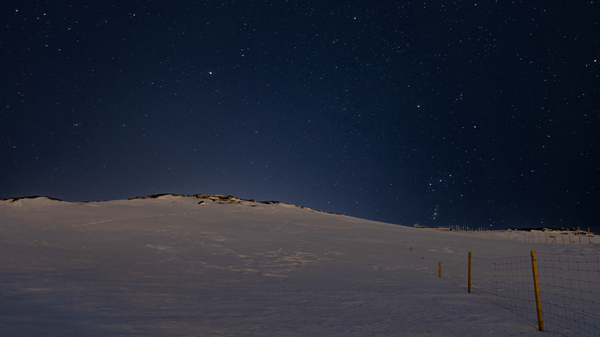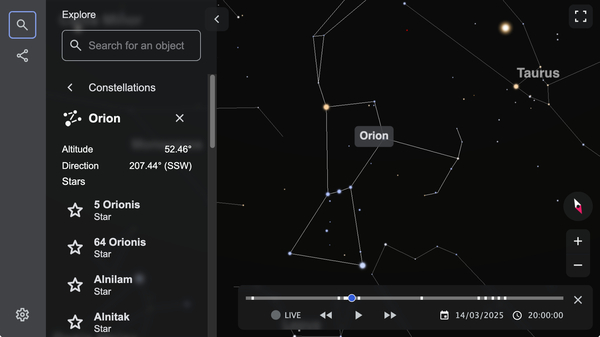How to Spot Orion in the Winter Sky
November to March is the best time to hunt for the constellation of the mythical giant.

Orion shines brightly at the lower right of the horizon on a cold and clear night in Norway.
©iStockphoto.com/Burk Ucak
Winter (in the Northern Hemisphere) is the ideal time to view Orion. At this time of year, it is on the same side of the Sun as the Earth, so the stars in the constellation shine brightly from after dusk to before dawn, in the right conditions.
By June, our planet’s position changes and the light of the Sun starts to interfere with our view of Orion.
Hunting for the Hunter
One of the easiest ways to locate this famous star group is to use our Night Sky Map, which features a calendar and slider tool to find the best viewing times in your part of the world.


A Night Sky Map view of Orion over New York.
©timeanddate.com
You can also find Orion by orienting yourself towards the southern horizon (or the northern horizon if you are in the Southern Hemisphere) and picking out Sirius, the brightest star twinkling overhead.
Once you locate Sirius, raise your sights further up to find Betelgeuse and Rigel, the two most prominent stars in the constellation.
Not a Constellation
Orion’s famous belt sits about halfway between Betelgeuse and Rigel, with its three bright stars forming a neat and easy-to-identify line.
Raising your gaze up from the belt will lead you to two prominent stars that mark the hunter’s shoulders, and scanning down toward the horizon will lead you to the duo of stars that represent his feet.
Orion’s Belt itself is an asterism, rather than a constellation. It can be a little challenging to tease out the difference between these two types of star groupings, but the thing to remember is that a modern constellation is an entire sector of the night sky that includes the mythological image. An asterism, on the other hand, is another, usually smaller star pattern that is not recognized as a constellation.
What are asterisms? What are constellations?The Stuff of Legends
According to Greek mythology, Orion was a giant hunter who roamed the Earth until he was eventually killed by the sting of a scorpion. In tribute, Zeus was supposed to have set both the hunter and the scorpion (Scorpio) into the heavens so that they would find a form of immortality.
As with many of the ancient Greek myths, there are many versions of Orion’s story, and some tales include wildly violent episodes like the assault on Merope and Orion being blinded by her father in revenge.
The Greeks weren’t alone in noticing the prominence of the stars in this part of the sky. Ancient Indian astronomers also saw the formation, and interpreted the shape as a king shot by an arrow, while the Egyptians thought of it as the resting place of the soul of Osiris, God of the Dead.
Other Winter Stars and Asterisms
Orion isn’t the only prominent star formation easily visible in winter. From late December to late March, some other notable asterisms and stars shine their brightest. Stargazers watch for the red super giant star Betelgeuse, the Horsehead Nebula, and the Orion Nebula, all quite visible in the right conditions.
The night sky looks different in the Southern Hemisphere during these months, and skywatchers in that part of the world look for the constellations of Hydra, Eridanis, and Puppis.
View the night sky in Sydney, Australia